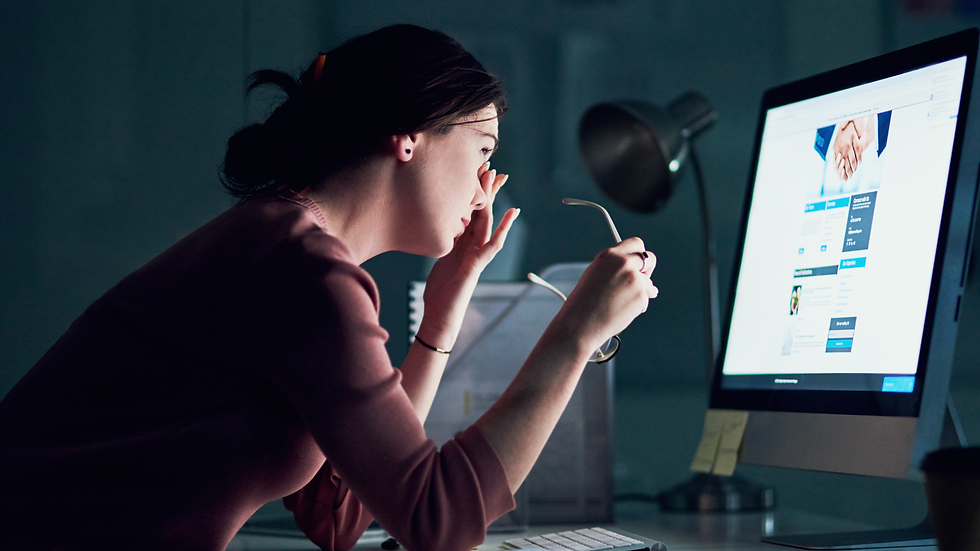Tired Eyes? Here Are 8 Gentle Tips to Relieve Eyestrain
- Clardoon Health

- Aug 11
- 4 min read

We live in a world where screens are everywhere. Whether you're working on a laptop, scrolling through your phone, bingeing your favourite show, or attending virtual meetings, your eyes are constantly “on.”
If your eyes feel tired, dry, or even sore by the end of the day, you’re likely experiencing eyestrain—a common yet often overlooked side effect of our digital lives. And while it might not seem serious at first, regular eyestrain can affect your focus, productivity, and even your mood.
The good news? A few small, consistent habits can help prevent and ease eyestrain—without needing medication or invasive treatments.
Here are 8 practical, research-backed tips to help protect your vision and keep your eyes feeling refreshed.
1. Follow the 20-20-20 Rule
A straightforward yet powerful method, the 20-20-20 rule is a favourite among eye care professionals. Every 20 minutes, take a 20-second break to look at something 20 feet away. This brief pause gives your eye muscles a chance to relax and reset, especially after prolonged screen use.
Even short breaks like this help reduce fatigue. When possible, try pairing this with getting up to stretch or grab a glass of water—it benefits both your eyes and your overall circulation.
2. Adjust Your Screen Setup
Proper positioning matters. Your screen should be at arm’s length and slightly below eye level. This helps maintain a natural head and neck posture while minimising unnecessary strain on your eyes.
Many people also overlook the value of adjusting text size and contrast. Enlarging font settings or switching to dark mode can make reading more comfortable, particularly in low-light environments. Think of it as creating an eye-friendly workspace that supports—not stresses—your vision.
3. Pay Attention to Lighting
Too much or too little light can both trigger eyestrain. Aim for balanced lighting that reduces glare without making the space too dim. If you're reading, light should ideally come from behind and shine directly onto the page or screen.
Glare from windows or overhead lights can reflect off screens and force your eyes to work harder. Try closing blinds, using anti-glare filters, or rearranging your desk to reduce bright reflections. When watching TV in the evening, dim the lights slightly to ease contrast strain.
4. Use Reference Materials Wisely
If you regularly switch between a screen and printed documents, constantly moving your eyes and neck can add to strain. Use a document holder beside your monitor so you don’t need to tilt your head or refocus so often.
It’s a simple adjustment that makes a big difference—especially during long work or study sessions.
5. Blink Often and Use Eye Drops if Needed
You probably don’t notice it, but your blink rate drops significantly when you’re focused on a screen. Less blinking means your eyes dry out faster, leaving them feeling scratchy or irritated.
Make it a habit to consciously blink more often, especially during concentrated tasks. If dryness persists, artificial tears or lubricating eye drops can help. Look for preservative-free formulas if you’re using them multiple times a day.
6. Create a Comfortable Air Environment
Dry, recirculated air—common in offices or air-conditioned rooms—can worsen eye discomfort. If you’re spending hours in such environments, consider using a humidifier to maintain moisture in the air. Try to avoid sitting directly under vents or fans that blow air into your face.
Relocating your workspace, adjusting airflow, or taking short breaks outside can provide much-needed relief when your eyes start to feel the effects of stale indoor air.
7. Rethink Your Eyewear
If you already wear glasses or contact lenses, they may not be optimised for screen use. Schedule an eye exam to check whether you’d benefit from computer-specific lenses or coatings that reduce blue light and glare.
For contact lens wearers, consider taking regular breaks to wear glasses, especially if your eyes feel dry or tired by the end of the day. Giving your eyes a rest from contacts can improve comfort and overall eye health.
8. Know When to Seek Help
Sometimes, despite your best efforts, eyestrain can linger or worsen. If you’re dealing with frequent headaches, blurry vision, or eye fatigue that doesn’t improve with rest, it’s time to speak with a professional. Eyestrain can sometimes signal an underlying issue that needs attention—like uncorrected vision problems or screen-related stress.
Don’t brush it off as something you just have to “live with.” Taking care of your eyes now can prevent more serious issues down the line.
Protect Your Eyes—They Do More Than You Think
We rely on our eyes every moment of the day, often without realising just how much we ask of them. Preventing eyestrain isn’t just about comfort—it’s about protecting your long-term vision, productivity, and quality of life.
If you spend long hours in front of screens or feel the strain of a busy lifestyle, the right nutritional support can make a real difference. USANA Visionex™ DS is a science-backed supplement designed to support eye health with key nutrients like lutein—helping to filter blue light and reduce oxidative stress.
Curious if it’s right for you? Book a free consultation with a certified health coach to explore how USANA Visionex—and other personalised wellness strategies—can support your vision and overall well-being. Your eyes—and your future self—will thank you.
References:
Silver, N. (2024, August 29). Eyestrain: 8 tips for prevention. Healthline.




Comments